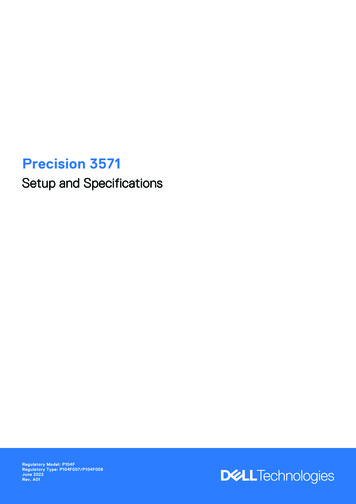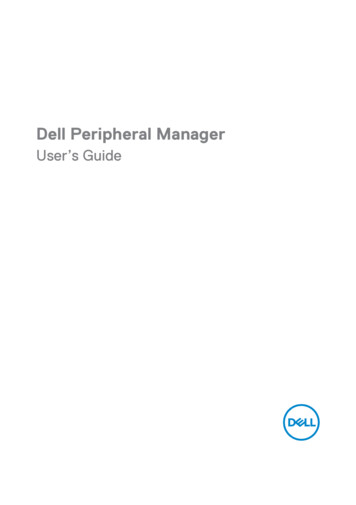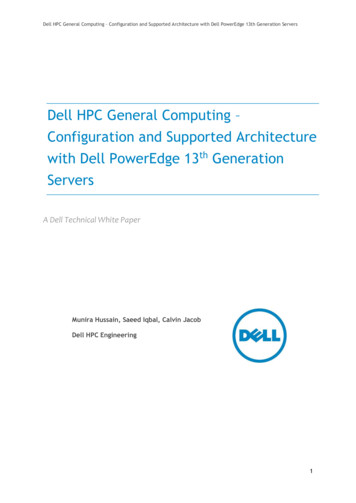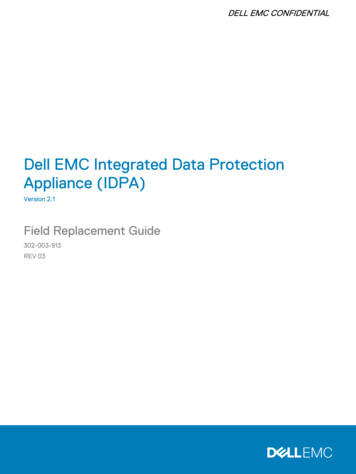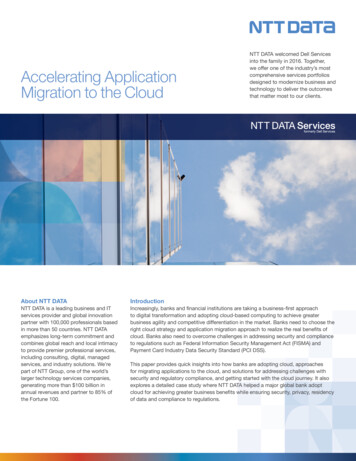
Transcription
Accelerating ApplicationMigration to the CloudNTT DATA welcomed Dell Servicesinto the family in 2016. Together,we offer one of the industry’s mostcomprehensive services portfoliosdesigned to modernize business andtechnology to deliver the outcomesthat matter most to our clients.About NTT DATAIntroductionNTT DATA is a leading business and ITservices provider and global innovationpartner with 100,000 professionals basedin more than 50 countries. NTT DATAemphasizes long-term commitment andcombines global reach and local intimacyto provide premier professional services,including consulting, digital, managedservices, and industry solutions. We’repart of NTT Group, one of the world’slarger technology services companies,generating more than 100 billion inannual revenues and partner to 85% ofthe Fortune 100.Increasingly, banks and financial institutions are taking a business-first approachto digital transformation and adopting cloud-based computing to achieve greaterbusiness agility and competitive differentiation in the market. Banks need to choose theright cloud strategy and application migration approach to realize the real benefits ofcloud. Banks also need to overcome challenges in addressing security and complianceto regulations such as Federal Information Security Management Act (FISMA) andPayment Card Industry Data Security Standard (PCI DSS).This paper provides quick insights into how banks are adopting cloud, approachesfor migrating applications to the cloud, and solutions for addressing challenges withsecurity and regulatory compliance, and getting started with the cloud journey. It alsoexplores a detailed case study where NTT DATA helped a major global bank adoptcloud for achieving greater business benefits while ensuring security, privacy, residencyof data and compliance to regulations.
Cloud adoption trends in banking,investment and financial servicesMajor global banks are increasing theircloud investments and shifting enterpriseworkloads to both public and privatecloud. In fact, a recent RightScalesurvey found that private cloud adoptionincreased from 63% to 77%, drivinghybrid cloud adoption up from 58% to71% year over year.Cloud-native andcloud-enabledcontinuous delivery71%hybrid cloudShifting PrivateTo HybridPrivate cloud adoptionincreased from 63% to77%, driving hybrid cloudadoption up from 58% to71% year over year.1New low-codeplatforms deliver atdigital clock speedBanks, and insuranceand financial servicesorganizations are usinginnovative low-codeplatforms to quickly buildmulti-channel customerfacing cloud applications.22Banks, and insuranceand financial servicesorganizations are usinginnovative low-codeplatforms to quickly buildmulti-channel customerfacing cloud applications.211%Banks adopt public cloud in many areas,which include but are not limited to: Collaboration: Connectingemployees across branches toaccess banking systems Development and testing: Enablingbanks’ development and testingteams to quickly and easily createvirtual environments, which increasesagility Analytics: Integrating customer dataacross banking platforms to enablenear-real-time insights Business intelligence on demandMajor global banks follow a hybridapproach due to security, privacy andregulatory concerns. Public cloudbased services are leveraged fornon-critical functions such as emailmanagement, collaboration and contentmanagement. Enterprises adoptexternally hosted, private cloud-basedservices for application development,test environments and processing andanalytics.shift of IT budget fromtraditional in-house ITdelivery toward cloudcomputing as a new deliverymodel by 2016.60%of new applications will usecloud-native applicationarchitecture to enable fasterinnovation and agility by 2017.35%of new applications will usecloud-based continuousdelivery by 2018.31.“2016 State of the Cloud Report.”RightScale. January 2016.2.“The Forrester Wave: Low-CodeDevelopment Platforms, Q2 2016.”Forrester and OutSystems.3.“IDC FutureScapes 2015.”
Cloud application migration approachTypically, organizations who want tomove to cloud need to have a cloudstrategy in terms of choosing the rightcloud models and cloud service providers(CSPs) based on their business and ITstrategy. Organizations also need tohave an application migration strategyto choose the right migration paths andoptions for their applications basedon their goals, priorities, risks, returnon investment, technology, platformand tools. Some applications can bedeployed in the cloud using re-host orlift-shift strategies while others need tobe optimized for cloud to realize the realbenefits.This approach is based on an applicationportfolio analysis where existingapplications are analyzed for complexity,dependency on external applications,design elements and user interfaces.Redundant applications are groupedbased on their functionalities, so theycan be optimized to reduce the numberof applications on the target cloudplatform during the migration phase.Figure 3 depicts our framework for cloudreadiness assessment.The decision to choose the right cloudstrategy and application migrationstrategy is primarily based on anorganization’s existing application andinfrastructure portfolios. This meansthe cloud application migration journeybegins with the assessment phase.While there are different approaches formigrating applications to the cloud, NTTDATA suggest an incremental and phasedapproach. Figure 2 depicts one of thesuggested approaches for migratingapplications to the cloud.TechnologyApplicationstechnology stackStrategy and assessmentTimeline and effortPhase 0PilotApplicationsCloud suitability filtersCloud amenability analysisApplication target cloud amenabilityindex with heat mapCloud migration business caseROI and TCO cost-benefit analysisIntegrationApplication external/internal integrationMigration roadmapWave-based migration plansInfrastructureApplication infrastructurecapacity /sizingSoftware-as-a-service (SaaS)enablementSaaS amenability reportPortfolioassessmentAzure MAP tools Figure 3: NTT DATA cloud readinessassessment frameworkTransformation, automation, implementation and managementPhase 1Non-criticalapplicationsPhase 2Business-criticalapplicationsPhase 3Survival-criticalapplications Assess cloud amenability Define the cloud strategy Determine cost benefits,technical feasibility and risks Define governance model Build pilot Migrate dev/test environments Lift and shift non-criticalapplications to public cloud Move third-party andreference data to public cloud Build continuous integrationpipeline Lift and shift/lift, optimize andshift business-criticalapplications Move transactional andaccount data Modernize legacy applicationsfor cloud Build continuous developmentpipeline Modernize legacyapplications for cloud Lift and shift/lift, optimizeand shift survival-critical andcustomer-orientedapplications Integrate applicationperformance management Cloud maturity3AssessmentrulesFigure 2: Cloud application migrationapproach and roadmap
Addressing security and regulatorycompliancesAn assessment of cloud readiness is performed based on workload patterns, resultingin a cloud amenability map that lists various groups of applications and their risks.Figure 4 depicts the classification of sample applications and business processes forinvestment banking.Non-critical applicationsPublic cloudTrademanagement(front office )MiddleofficeClearing(backoffice) C lient/partner/trading portals P re/post- trade analytics I T trade support R eference datamanagementRegulatory r eportingCommon businessprocessesEmail, employeecollaboration toolsData managementservicesMarket reference data,Securities reference dataBusiness-critical applicationsHybrid cloudSurvival-critical applicationsPrivate on-premises cloud C ustomer service C ustomer acquisition P ricing and structuring T rade capture andenrichment C lient onboardingDeal confirmation R isk analysis P ost-trade compliance R D S Cegulatory reportingepository and investor servicesecurities lendingollateral managementCRM, AML, SOX risksmanagement I nvestment/fundaccounting I ncome and dividendprocessingRisk monitoring andreportingProduct data, pricing data,trade data, advisory dataFigure 4: Sample applications/business process classification for investment banking —actual classification may vary depending on assessment of an organization’s applications andbusiness processesBased on the assessment results, the deployment architecture is designed and amigration plan (for existing applications) and execution plan are created. One or moreof the following application migration options are chosen based on the outcome of theassessment: Re-host or lift-shift: Redeployment of existing applications on cloud infrastructurechanging an application’s code and infrastructure configuration Refactor or optimize: Change of application code and configurations for opensource and deployment of refactored applications on cloud infrastructure Re-architect: Breaking up monolithic application functions into modular servicesbased on distributed and modern architectures such as microservices architecture Rewrite: Rewrite existing applications leveraging cloud-native platforms such asPivotal Cloud Foundry for accelerated delivery Replace: Replace existing applications with commercial SaaS to satisfy thebusiness requirements4CPSs, such as Amazon Web Services(AWS) and Microsoft Azure, offer out-ofthe-box cloud services that can be usedoff the shelf by banks. This helps themovercome challenges with security andregulatory compliance such as: Compliance with regulatorystandards: CSPs assure compliancethrough various certifications.For instance, Azure and AWS arecompliant with FISMA Moderatestandards and with PCI DSS. WithPCI DSS, AWS complies with a setof controls important to companiesthat handle credit card information.With the FISMA standards, AWScomplies with a wide range ofspecific controls required by U.S.government agencies. Data security and residency: Useencryption and tokenization servicesprovided by CSPs for securing dataat transit and at rest depending onthe requirements. For data residencyrequirements, a tokenizationmechanism can be used to replacesensitive fields with randomlygenerated tokens that are structurallysimilar, but have no mathematicalcorrelation to the original data.The encryption and tokenizationmethods, keys and tokens can besecurely stored on-premises andcontrolled by banks. Auditing and logging: Banks cankeep a signed audit trail of whichusers performed what actionsleveraging audit trail servicesprovided by leading CSPs. Bankscan implement sign-in certificationand encryption mechanisms for thelog files to be stored in the cloud.They can also implement robustaudit logging and best practicesto quickly detect unauthorizedaccess to services, resources andapplications in cloud.
Client success storyPrivate cloud deployment for a leading bank and financial institution in the U.S.BackgroundA leading provider of banking, mortgage, investing, card, insurance, consumerand commercial financial services in the U.S. wanted to embark on their cloudtransformation by migrating 1,400 applications across lines of business to private cloud.They had concerns about security, privacy and residency of their transactional, accountand customer data, and approached NTT DATA Digital Business Services for a solution.Challenges: Risk of moving applications to the cloud due to security, privacy and regulatorycompliance Security threats associated with cloud services — sensitive information needed tobe protected to ensure only authorized users could access sensitive data Reduced performance for data-intensive applications due to cloud networkbandwidth and latency Unable to ensure availability of cloud services and the ability to build applications inthe cloud for high performance Difficulty integrating applications and data between multiple environments Longer lead time accessing 1,400 applications and identifying candidateapplications for cloud Longer time to provision and install all required software Needed to improve application delivery speed — with no compromise on quality orregulatory complianceSolution: Enabled assessment of all levels of security - policy security, environment andinfrastructure security, systems and platform security and data security Accelerated cloud amenability analysis of applications and business processes withthe Cloud Portfolio Assessment solution by NTT DATA that automatically generatesa heat map report based on the inputs from the application portfolio analysis Built a private cloud using a Microsoft Cloud Platform System (CPS) joint solutionthat provided portals for self-provisioning of virtual machines Automated the provisioning of environments using our pre-built environmentprovisioning patterns and templates Implemented robust data security and data residency solution using SecureSockets Layer, encryption and tokenization techniques Developed a comprehensive disaster recovery and availability plan, optimallydesigned and configured input/output operations per second for I/O intensiveworkloads in Microsoft CPS and demonstrated improved performance by runningcapacity test cases under various loads and conditions Built continuous delivery pipeline through integration of various tools includingtesting tools and orchestrated release processes using the DevOps Automationsolution by NTT DATA with extended Microsoft Azure plugins and adapters Enabled self-service and automated deployment of applications to private cloudusing our pre-built deployment blueprints, templates and scriptsResults: Created a private cloudenvironment similar to a publiccloud platform-as-a-serviceenvironment Provided a foundation forensuring all four levels ofsecurity prior to migration withour risk assessment framework Enabled faster assessment ofapplications in just three weekswith our cloud amenabilityframework Enabled provisioning ofenvironments in one day usingour pre-built templates and codewith Microsoft CPS Scaled cloud-migratedapplications to meet scalability,performance, integration andsecurity Built a one-click deployment todeploy to Windows Azure Pack Enabled feedback to developersin one to two hours Reduced application releasetime to one day Estimated expected reductionin production and environmentrelated issues around 75%SummaryEnterprise organizations shouldfollow a hybrid approach and,based on their cloud readinessand risks assessments, adoptan incremental phased migrationstrategy, leveraging different cloudservice models and migration typesfor a better return on investment andbusiness benefits.Visit nttdataservices.com to learn more.NTT DATA partners with clients to navigate the modern complexities of business and technology, delivering the insights,solutions and outcomes that matter most. We’re a top 10 global IT services and consulting provider that wraps deepindustry expertise around a comprehensive portfolio of infrastructure, applications and business process services. 2016 NTT DATA, Inc. All rights reserved. November 2016 NTTD1130-cloud-adoption-white-paper.indd Rev. 1.0
Cloud migration business case ROI and TCO cost-benefit analysis Migration roadmap Wave-based migration plans Software-as-a-service (SaaS) enablement SaaS amenability report Cloud suitability filter s Applications Figure 3: NTT DATA cloud readiness assessment framework Figure 2: Cloud application migration approach and roadmap



